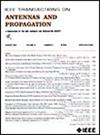Standalone Identification Antenna for Resonator Tag-Free Far-Field Chipless RFID Sensors
IF 5.8
1区 计算机科学
Q1 ENGINEERING, ELECTRICAL & ELECTRONIC
引用次数: 0
Abstract
In conventional chipless radio frequency identification (CRFID) systems, antennas and separate resonator tags work interdependently—resonator tags rely on antennas for data transmission, while antennas alone cannot perform radio frequency identification (RFID) operations without them. This research introduces, for the first time, a stand-alone identification antenna (SIDA), eliminating the need for supplementary resonator tags to independently perform CRFID functions in the far-field. SIDA is designed as a planar monopole antenna (PMA) in the ultrahigh frequency (UHF) range, employing a new mechanism of notch element concentration (NEC) on its patch. Intermingled coupling resonators (ICRs) are utilized as notch elements to generate multiresonating coding bits in far-field radiation. SIDA prototypes are fabricated on Rogers RO4003C substrate with distinctive 6-bit multiresonating codes (111111 and 111101) within the 0.78–1.38 GHz range. By eliminating the need for separate resonator tags, SIDA significantly improves conventional retransmission (ReTx)- and received signal strength (RSS)-based CRFID operations. Both in ReTx and RSS systems, SIDA is applied as resonator tag-free far-field CRFID sensor for the simultaneous detection of partial discharge (PD) defect in high-voltage (HV) systems and RF identification of PD-affected HV equipment. Experimental performances prove SIDA’s suitability as far-field CRFID sensor and its prospect in multipurpose smart sensing uses by eliminating the need for additional resonator tags.用于谐振器无标签远场无芯片RFID传感器的独立识别天线
在传统的无芯片射频识别(CRFID)系统中,天线和单独的谐振器标签相互依赖地工作-谐振器标签依赖天线进行数据传输,而天线单独无法执行射频识别(RFID)操作。这项研究首次引入了一种独立的识别天线(SIDA),消除了在远场独立执行CRFID功能时需要补充谐振器标签的需要。SIDA是一种超高频平面单极天线(PMA),在其贴片上采用了一种新的缺口元素浓度(NEC)机制。利用混合耦合谐振器作为陷波元件在远场辐射中产生多共振编码位。SIDA原型机是在Rogers RO4003C衬底上制造的,在0.78-1.38 GHz范围内具有独特的6位多谐振码(111111和111101)。通过消除对单独谐振器标签的需求,SIDA显着改善了基于传统重传(ReTx)和接收信号强度(RSS)的CRFID操作。在ReTx和RSS系统中,SIDA被用作无谐振器标签的远场CRFID传感器,用于同时检测高压(HV)系统中的局部放电(PD)缺陷和受PD影响的高压设备的射频识别。实验性能证明了SIDA作为远场CRFID传感器的适用性及其在多用途智能传感应用中的前景,因为它无需额外的谐振器标签。
本文章由计算机程序翻译,如有差异,请以英文原文为准。
求助全文
约1分钟内获得全文
求助全文
来源期刊
CiteScore
10.40
自引率
28.10%
发文量
968
审稿时长
4.7 months
期刊介绍:
IEEE Transactions on Antennas and Propagation includes theoretical and experimental advances in antennas, including design and development, and in the propagation of electromagnetic waves, including scattering, diffraction, and interaction with continuous media; and applications pertaining to antennas and propagation, such as remote sensing, applied optics, and millimeter and submillimeter wave techniques

 求助内容:
求助内容: 应助结果提醒方式:
应助结果提醒方式:


